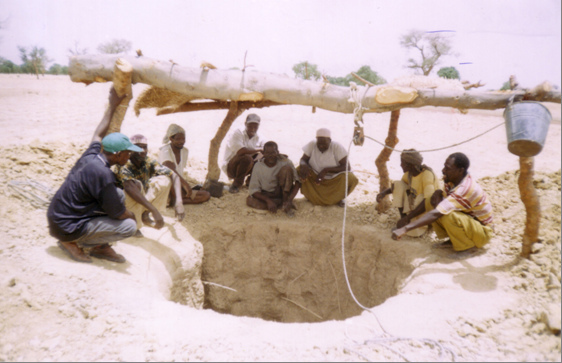Podcast: Play in new window | Download
Subscribe: RSS

After the well goes dry, there’s nothing much to do but talk about how much you miss the water…..(Photo by TREEAID/Flickr)
When the New York Times, the US Geological Survey and the United Nations declare a crisis in the same week — the same crisis — it just might be that we have a problem. The one that the newspaper, the agency and the international organization were all worried about last week: the world is running out of water. It’s a situation that resembles the impending shortages of oil — as the supplies dwindle, the pumps run faster.
Water is a strange beast. When we “use” it or “consume” it, we don’t destroy it. We might alter its state (liquid to vapor or solid), but the total amount of water on the planet never changes. Which sounds great, but most of the water is unavailable to us humans and our industrial pretentions, because it is locked up in ice, or because it is too salty or, increasingly, too polluted. That’s why we rely on underground water.
A USGS study released last week documents that this country’s 40 major aquifers are being exhausted at an increasing and alarming rate. A few days prior to its appearance, the New York Times published a major piece on the depletion of the High Plains, or Ogalalla, Aquifer that underlies the farming country from North Dakota to Texas, observing:
“…across the rolling plains and tarmac-flat farmland near the Kansas-Colorado border, the effects of depletion are evident everywhere. Highway bridges span arid stream beds. Most of the creeks and rivers that once veined the land have dried up as 60 years of pumping have pulled groundwater levels down by scores and even hundreds of feet.”
And, in response to a warning from a UN-related group of 500 scientists that most people on earth will face water shortages within two generations, Secretary General Ban Ki-moon said “Under current trends, future demands for water will not be met.” Which is a very nice way of stating a terrible fact.
The USGS study calculated that during the 20th Century, use of groundwater averaged about 245 million gallons per year: during the 21st Century, consumption has averaged 662 million gallons per year, and is increasing fast. In the United States, much of the groundwater — notably the Ogallala Aquifer — is fossil water. Like oil, it was deposited by geological processes (in this case, the glaciers of the last Ice Age) that have run their course. Other aquifers were formed by and are replenished by rain and surface water, but not the Ogallala (the rain that does makes it down there amounts to a trickle). The New York Times piece laments the plight of Kansas, whose chunk of the Ogalalla has lost an average of 4.25 feet in just the past two years. And that’s the average; in some places you have to go 30 feet farther down to get wet.
The main draw on underground water has been by agriculture, which in the American Mid- and Southwest is desperate to replace the rains that no longer come to a region afflicted by an ongoing and worsening drought. That this drought is a manifestation of global warming brought on by industrial-scale pollution (from such activities as intensive agriculture) is not even mentioned in the Times piece.
Agriculture plays another role in reducing the amount of water available for other activities, such as drinking. As the 500 UN water experts point out, farm runoff is contributing to algae-clogged rivers and lakes, and dead zones in the world’s oceans. They estimate that nearly 2 of every three Americans now live within 10 miles of a water source that is impaired — which is to say severely polluted, or running dry.
Another week, another group of experts with their hair on fire about impending catastrophe. But, wait! What’s that about the Kardashians going broke?